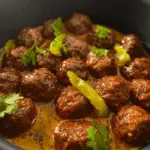Coconut Salmon Curry is a warm and inviting dish that brings the exotic richness of Southeast Asia right to your kitchen. With flaky, tender salmon nestled in a luscious coconut curry sauce, this recipe beautifully balances the sweetness of coconut milk, the zest of lime, and the punchy heat of red curry paste. The addition of fresh vegetables like bell peppers and zucchini not only enhances the flavor and texture but also brings color and nutrition to the plate.
This comforting yet elegant dish is a quick solution for weeknight dinners and impressive enough for guests. Its depth of flavor comes together in just one pan, making cleanup a breeze. Serve it over fragrant jasmine rice for a complete meal, or swap in cauliflower rice for a low-carb option. With its soothing coconut base and layers of aromatic spice, this curry is sure to become a go-to favorite for lovers of bold, global cuisine.
Full Recipe:
Ingredients:
-
4 salmon fillets
-
1 tablespoon coconut oil
-
1 small onion, finely chopped
-
3 garlic cloves, minced
-
1 tablespoon freshly grated ginger
-
2 tablespoons red curry paste
-
1 can (13.5 oz) coconut milk
-
1/2 cup fish broth or water
-
1 tablespoon fish sauce
-
1 tablespoon brown sugar
-
1 red bell pepper, thinly sliced
-
1 zucchini, sliced
-
Juice of 1 lime
-
Fresh cilantro and red chili slices for garnish
-
Salt and pepper to taste
-
Cooked jasmine rice, for serving
Directions:
-
Heat coconut oil in a large skillet over medium heat. Add chopped onions and sauté until translucent.
-
Stir in garlic and ginger, cooking for another minute until fragrant.
-
Add red curry paste and cook for 2 minutes to release its aroma.
-
Pour in coconut milk and fish broth. Stir in fish sauce and brown sugar. Bring to a simmer.
-
Add bell pepper and zucchini, cooking for 3–4 minutes until slightly tender.
-
Gently nestle salmon fillets into the sauce. Cover and simmer for 8–10 minutes, or until salmon is cooked through.
-
Finish with lime juice and season with salt and pepper.
-
Garnish with fresh cilantro and red chili slices. Serve hot over jasmine rice.
Prep Time: 10 minutes | Cooking Time: 20 minutes | Total Time: 30 minutes
Kcal: 420 kcal | Servings: 4 servings
Coconut Salmon Curry is a vibrant, aromatic, and deeply comforting dish that brings together the creamy richness of coconut milk with the bold heat of red curry paste and the delicate flakiness of salmon. This dish, inspired by Thai and Southeast Asian culinary traditions, has quickly become a favorite in home kitchens for its flavor complexity and ease of preparation. With its rich textures, aromatic spices, and nourishing ingredients, Coconut Salmon Curry is not only a feast for the senses but also a wholesome addition to your recipe collection.
Whether you’re an adventurous home cook or someone just venturing into Asian-inspired meals, this dish offers the perfect introduction to the power of global flavors fused with simple cooking techniques.
Why Coconut Salmon Curry is So Popular
One of the reasons Coconut Salmon Curry stands out is its perfect balance of taste, nutrition, and versatility. The mild sweetness of coconut milk mellows the spice from red curry paste, while fresh ingredients like lime, garlic, and ginger add brightness and depth. Salmon, a fatty fish rich in omega-3s, brings its naturally buttery texture into the mix, creating a dish that feels indulgent but is packed with nutrients.
It’s popular across diverse culinary platforms because it can be adapted to suit various dietary needs gluten-free, dairy-free, low-carb, and high-protein eaters alike can enjoy this dish. Whether served over fluffy jasmine rice, basmati, or even cauliflower rice, it holds up beautifully.
Culinary Origins and Cultural Influences
Coconut Salmon Curry takes inspiration primarily from Thai cuisine, where coconut milk and curry paste are foundational elements. Thai red curry paste, made with red chilies, lemongrass, galangal, garlic, and shallots, brings a layered heat and tanginess that’s characteristic of the region’s cooking style.
The use of coconut milk in curries dates back centuries in Southeast Asia, where it’s commonly used as a dairy alternative and flavor enhancer. Over time, as global cuisine evolved and fusion cooking became more prominent, dishes like this curry gained worldwide appeal and were adapted using local ingredients like salmon, which is more common in Western kitchens than tropical fish.
Flavor Profile and Texture
Coconut Salmon Curry offers a rich, creamy, and well-rounded flavor profile. The coconut milk adds a subtle sweetness and creamy mouthfeel, while the curry paste injects heat, spice, and aromatics. Freshly grated ginger and garlic enhance the savory umami base, while lime juice cuts through the richness with a touch of acidity.
The vegetables in the dish often bell peppers, zucchini, or even green beans introduce freshness and crunch, providing a contrast to the soft, flaky salmon. Garnished with fresh cilantro, red chili slices, or Thai basil, the dish finishes with a pop of color and herbal freshness that lifts the entire plate.
Health Benefits of Coconut Salmon Curry
This dish is not only delicious but also incredibly nourishing. Salmon is known for being high in omega-3 fatty acids, which are essential for heart and brain health. It’s also a great source of lean protein and vitamin D. Coconut milk contains lauric acid, a type of healthy fat that may support immune function and energy.
Additionally, ingredients like ginger and garlic have natural anti-inflammatory and antibacterial properties. Combined with colorful vegetables, this curry provides a wealth of vitamins, antioxidants, and fiber. For those watching their carbohydrate intake, substituting white rice with cauliflower rice can transform this meal into a low-carb powerhouse without compromising taste.
Customization and Variations
One of the best aspects of Coconut Salmon Curry is how easy it is to adapt. You can use different proteins, such as shrimp, chicken, tofu, or tempeh. If salmon isn’t available or preferred, white fish like cod or halibut can also be excellent alternatives.
Vegetables can be swapped based on what’s in season carrots, broccoli, snow peas, eggplant, or baby corn are all great additions. You can also adjust the level of spiciness by altering the quantity of red curry paste or adding sliced fresh chili. For a richer dish, a splash of heavy cream can be added, while a squeeze of lemon juice or tamarind paste can introduce more tang.
Serving Suggestions
Traditionally, this curry is best enjoyed with steamed jasmine rice that absorbs the creamy, spicy sauce. However, it can also be served with brown rice, quinoa, or rice noodles for a different experience. A side of warm naan or roti can also pair beautifully, helping to mop up every last drop of sauce.
For a complete meal, consider pairing it with a light cucumber salad, mango slaw, or pickled vegetables. A glass of chilled white wine like Sauvignon Blanc or Riesling complements the spicy and creamy notes, balancing the richness with acidity.
Tips for Making the Best Coconut Salmon Curry
- Use full-fat coconut milk: It delivers the best creamy texture and rich flavor.
- Don’t overcook the salmon: Add the fish towards the end of the cooking process so it remains tender and moist.
- Sauté your aromatics well: Giving enough time for the onions, garlic, and ginger to cook enhances the base flavor of the dish.
- Simmer gently: Avoid boiling the curry aggressively, as this can break down the salmon and make it tough.
- Add fresh herbs last: Cilantro or Thai basil added at the end will retain their vibrant color and fresh aroma.
Common Mistakes to Avoid
- Skipping the curry paste sauté step: Cooking the curry paste before adding liquids helps release its full aroma and flavor.
- Using light coconut milk: While it’s lower in fat, it often results in a thinner sauce that lacks the luscious creaminess that defines this dish.
- Overloading with vegetables: Keep the vegetable additions balanced so they don’t overpower the curry’s star ingredients—salmon and coconut.
- Cooking salmon from frozen: Thaw your salmon beforehand to ensure even cooking and better texture.
Storing and Reheating
Coconut Salmon Curry stores well in an airtight container in the fridge for up to 3 days. When reheating, do so gently over low heat to avoid curdling the coconut milk or overcooking the salmon. This dish also freezes moderately well, but for best texture, fresh is always preferred.
If freezing, consider separating the salmon and vegetables from the curry sauce, freezing them separately, and recombining during reheating for optimal results.
Conclusion: A Go-To Curry for Any Home Cook
Coconut Salmon Curry is a standout dish that embodies everything we love about globally-inspired home cooking rich in flavor, packed with nutrients, and endlessly adaptable. It’s the perfect meal to prepare when you want something quick yet gourmet, comforting yet health-conscious.
Whether you’re looking for a weeknight dinner idea, a recipe to impress guests, or a meal-prep favorite, this curry delivers on all fronts. With bold flavors, creamy texture, and vibrant presentation, it’s no surprise this dish has found a place in modern kitchens around the world.






